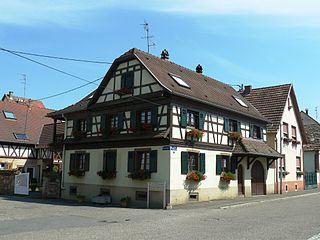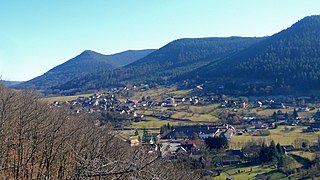Visitor attractions
The arboretum started as an experimental plantation of Douglas Fir established in 1885. Today the range of trees is more remarkable, including a rare sequoia discovered in 1960 and a snake-tailed spruce.
Visitors to the village will also encounter an unusual range of art works, including 17 sculptures representing animals and philosophical concepts.
At the upper exit to the village a fountain dedicated to the fate of Haïdi Hautval, supported by an inscription in no fewer than eleven languages, recalls a locally famous figure from history.
History
Le Hohwald, which is still a young commune, owes its birth to a decree of the court of Colmar of 16 April 1867. It groups together various hamlets which were administratively part of five communes: Breitenbach, Erlenbach, Barr, Andlau and Ottrott and were grouped together in a single entity comprising about 500 inhabitants at its birth. Towards the end of the Middle Ages, the territory was shared by three co-owners: the bishop of Strasbourg with the lords of the Val de Villé in co-ownership, the lordship of Barr and the abbey of Andlau.
The first inhabitants of Hohwald seem to have settled after the Thirty Years' War. The town of Strasbourg, which owned the land, encouraged immigrants from Switzerland (mostly Anabaptists) to settle in the area. They usually settled in the stubble fields to raise livestock and clear the land. They gradually built farms and sawmills to exploit the wood, which later became hamlets. However, the area did not really develop until the middle of the 17th century.
From the 19th century onwards, Le Howald emerged from its isolation thanks to the construction of roads and a railway. A health resort was established and many prominent people from all over Europe came to the town at the beginning of the 20th century.
Throughout the 19th century, the Hohwald was known as a world-renowned tourist resort. A few rich people from Strasbourg set up their second homes here and some farms were converted into guesthouses or hotels.
Important personalities from the political or artistic world, such as Sarah Bernhardt (1844-1923), the actor Benoît Constant Coquelin, known as Coquelin aîné (1841-1909), Marshal Joffre (1852-1931), Chancellor Konrad Adenauer (1876-1967) and Queen Juliana of the Netherlands (1909-2004) made the Hohwald their holiday resort during the summer. Émile Mathis (1880-1956), the manufacturer of Mathis cars in the inter-war period (factories in La Meinau, a south-western district of Strasbourg), built the Mathis villa, typical of the Art Deco style of the thirties - due to the architect Armand-Albert Rateau - in which he came to recharge his batteries and where he welcomed the political and industrial personalities of the time.
The Hohwald is covered by a vast expanse of forest, about 9/10ths of which belongs to the town of Strasbourg.
This page is based on this
Wikipedia article Text is available under the
CC BY-SA 4.0 license; additional terms may apply.
Images, videos and audio are available under their respective licenses.
























